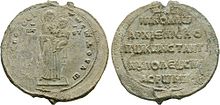Nicholas II of Constantinople
This article needs additional citations for verification. (October 2024) |
Saint Nicholas II of Constantinople | |
|---|---|
 Seal of Nicholas II of Constantinople | |
| Ecumenical Patriarch of Constantinople | |
| Died | 16 December 991 Constantinople |
| Venerated in | Orthodox Church, Catholic Church |
| Feast | 16 December |
Saint Nicholas II of Constantinople | |
|---|---|
| Ecumenical Patriarch of Constantinople | |
| Installed | April 980 |
| Term ended | 16 December 991 |
| Predecessor | Anthony III of Constantinople |
| Successor | Sisinnius II of Constantinople |
| Personal details | |
| Denomination | Eastern Orthodox, Chalcedonian Christianity |
Nicholas II of Constantinople (Greek: Νικόλαος Χρυσοβέργης;[a] died 16 December 991) was Ecumenical Patriarch of Constantinople[1][2] from 980 to 991.
Life
[edit]In 980, during the reign of Emperor Basil II, when Nicholas II was Ecumenical Patriarch, the Archangel Gabriel was believed to have appeared in the guise of a monk to the disciple of a certain monk at the Monastery of the Pantocrator in Mount Athos. The monk reported that the angel sang a new verse of the matins hymn, recorded on a slate still held at the monastery. Nicholas II received the relic in the cathedral of Hagia Sophia. The Axion Estin is still sung in Orthodox services.
Nicholas II's tenure also saw the completion of the Christianisation of Kievan Rus' and the appointment of the first metropolitan for Rus', Michael I of Kiev.
Patriarch Nicholas II was later canonised and is commemorated by both the Catholic Church and the Eastern Orthodox Church on 16 December.
Notes and references
[edit]Notes
[edit]- ^ Chrysoberges meaning "golden wand"
References
[edit]- ^ Jennifer Lawler (2011), Encyclopedia of the Byzantine Empire, McFarland, p. 328.
- ^ Richard Greenfield, Alice-Mary Maffry Talbot (2016), Holy Men of Mount Athos, Harvard University Press.
